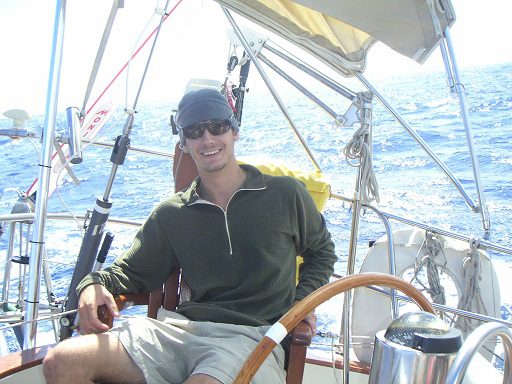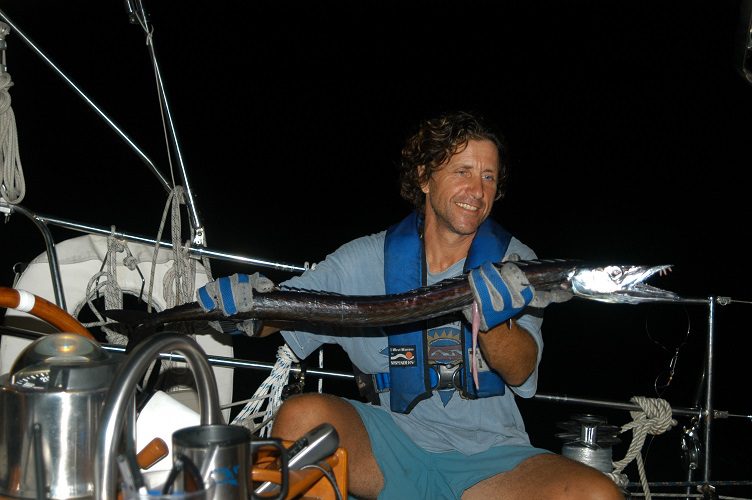The Start of the Last Leg
Afternoon, Friday Aug 20, 2004
(Matthew Lowry’s Birthday)
N 28o 32’
W 158o 28’
470 Miles north of Oahu, Enroute to the West Coast

We left Oahu within an hour after our new crew member, Peter (Pedro) Hunter, arrived from Los Angeles. No sooner had we shown him to his “quarters” and given him a safety briefing, then he was helping throw off the dock lines. After months of a relaxed itinerary, Lillian B. is now on a tight schedule to get Peter Fasoldt back in time for him to attend his Dad’s wedding, September 11. We have less than 23 days to go over 2500 miles.
According to conventional wisdom, the fastest way to sail from Hawaii to the West Coast this time of year is to first sail north and then east. In late summer, there is typically a stable high pressure region located northeast of Hawaii, surrounded by a large clockwise swirl of tradewinds. The direct route to San Francisco would cross through the calm center, while the longer route typically gets better winds, and is potentially faster. Added to this equation is the possibility of motoring through the calm spots.
In order to help plan the best route, we have enlisted the help of a weather router, “Commander’s Weather.” They analyze the current weather patterns and provide recommendations as to the fastest route based on boat speed and motoring capabilities. Coupled with their advice, we also have National Imagery and Mapping Agency Pilot Charts that provide historical data on the average winds and currents in the North Pacific. At 5 knots of speed through the water, even a half knot of current can make a significant difference in the actual distance traveled.
Having left the island of Oahu at 5:00 pm, we rounded the east tip of the island after sunset and headed north. Our preferred destination is San Francisco, but Seattle Washington may be closer, depending on which way the wind blows. We will make that decision later in the week. In either case, the recommended first leg is to head northward.
During the initial twelve hours of the trip, Pedro’s introduction to ocean sailing was a pounding ride through waves so choppy that the milk in the refrigerator literally curdled. It didn’t go sour, it just separated into curds and whey. After this rough start, however, the high pressure center began to dominate and the winds became light and from the south. About half the time we have used the spinnaker and the other half the engine, trying to develop the best strategy for getting to San Francisco on time. In anticipation of using the engine, we had loaded additional diesel on deck in the form of six five gallon jerry cans strapped to the starboard rail. Thus far, four days out, we’ve used about 40 gallons of our total supply of 100 gallons.

Meanwhile, the sun has been hot and the fishing good. So far, we’ve caught two nice size Mahi Mahi’s and a prehistoric looking fish that matches a picture in Kon Tiki of a rare snake mackerel (Latin name Gempylus). The first makes excellent meals, the latter, we’re not so sure about.
With a third crew member on board, the pace is much more relaxed than it was with just two. There is actually leisure time. If there were just a little more wind, it would be idyllic sailing. But, hopefully, within the next couple of days, we should emerge from the dominant high pressure system. If the prevailing winds live up to expectations, we will then be able give the motor a rest and begin sailing full time towards San Francisco.